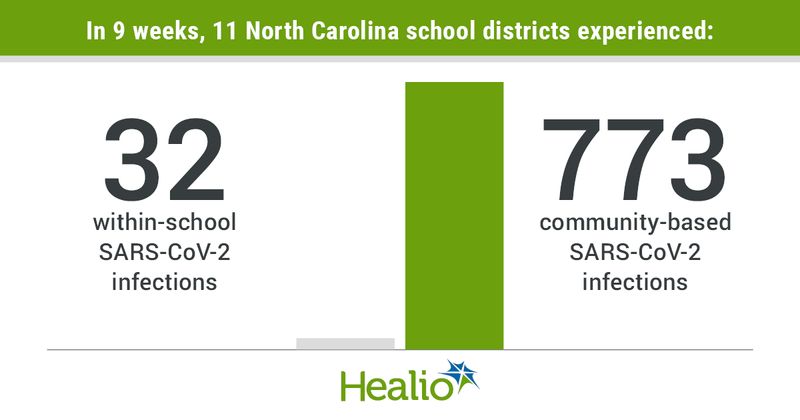Study finds ‘limited’ SARS-CoV-2 transmission in NC school districts
Click Here to Manage Email Alerts
Investigators determined that just 32 SARS-CoV-2 infections occurred in 11 North Carolina school districts during a 9-week period of in-person learning last year, according to a study published in Pediatrics.
The finding suggests that secondary transmission is far less common within schools than the community, researchers said.

The schools were participating in a program called the ABC Science Collaborative (ABCs) “to implement public health measures to prevent SARS-CoV-2 transmission and share lessons learned,” they said. North Carolina opened schools for hybrid learning that combined remote and in-person learning.
Kanecia O. Zimmerman, MD, associate professor of pediatrics at Duke University School of Medicine in North Carolina, and colleagues assessed 11 of 56 school districts participating in ABCs, from Aug. 15 through Oct. 23, in order to track the incidence and secondary transmission of SARS-CoV-2.
According to the authors, faculty and staff developed ABCs with three aims in mind — to educate school leaders, staff and community; have school-specific data drive decision-making; and generate new science to improve health-related outcomes for children.
“As the first quarter of instruction progressed, participating school districts agreed to a memorandum of understanding to share lessons learned,” the authors wrote.
Beginning 3 weeks before the start of the school year and continuing throughout all 9 weeks of the study period, the ABCs provided 60-minute educational webinars and Q&A sessions focused on prevention, transmission and outcomes of SARS-CoV-2 infection for administration, staff and parents of students.
Of the 115 total school districts in North Carolina, only 56 participated in the ABC Science Collaboration. Of those 56, 35 districts offered in-person instruction for part of the 9-week study period, but the 11 districts the authors reported on had in-person instruction for the entirety of the study period.
The authors determined that 773 SARS-CoV-2 infections occurred in the communities of the 11 school districts during the study period compared with 32 cases in the schools.
“If secondary transmission were as common in schools as in the community, we would anticipate 800–900 secondary infections within schools,” they wrote.
Among the 11 districts, six had no secondary infections, two had only one, and three districts had multiple. Six cases of secondary transmission occurred in the pre-K setting, 11 were in elementary schools, six in middle schools, five in high schools, and four in K-12 schools. There were no cases of child-to-adult within-school transmission.
“Our cohort study demonstrated that enforcing SARS-CoV-2 mitigation policies, such as masking, physical distancing, and hand hygiene, resulted in minimal clusters of SARS-CoV-2 infection and low rates of secondary transmission in schools, and did not cause a larger community infection burden,” the authors wrote.

